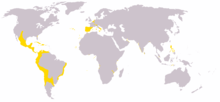Pax Hispanica
The Pax Hispanica (Latin for "Spanish Peace") refers to a period of twenty-three years from 1598 to 1621, when Spain disengaged from the European wars of religion that afflicted Europe during the previous century. Peace was signed with the Kingdom of France, the Kingdom of England, and the Dutch United Provinces.[1]

Peace was achieved by several treaties:
- 1598: The Peace of Vervins ended Spanish involvement in the French Wars of Religion. Spain had been at war with France, with only brief respites, since the Second Italian War of 1499.
- 1604: The Treaty of London concluded the Anglo-Spanish War on terms largely favourable to Spain.
- 1609: The Twelve Years' Truce halted the fighting in the Spanish Netherlands.
- 1610: Henry IV of France was assassinated.
Spain, the foremost great power of the time, had been mired in conflicts with the Dutch since the reign of Philip II.
In 1579 the Dutch founded the Utrecht Union, after the reconquest by Spain of many territories in the Dutch provinces by Alexander Farnese.
The following year, the Spanish Monarchy achieved, for the first time since the Muslim conquest, the territorial unity of the Iberian Peninsula through a personal union with the Kingdom of Portugal, thus creating the Iberian Union (1580–1640). After capturing Ostend from Spinola, the Dutch continued their rebellion, finally achieving the independence during the reign of Philip III of Spain.
After this, Spain held the peace in Europe for nine more years, when the Twelve Years' Truce ended. The peace ended when Spain got involved with the Thirty Years' War as Ferdinand II, Holy Roman Emperor was compelled to call on his nephew, King Philip IV of Spain, for assistance.
Notes
- Elliott, John Huxtable (1963). Imperial Spain 1469–1716. Edward Arnold. p. 317.
References
- Paul C. Allen (2000). Philip III and the Pax Hispanica, 1598–1621: The Failure of Grand Strategy. Yale University Press.